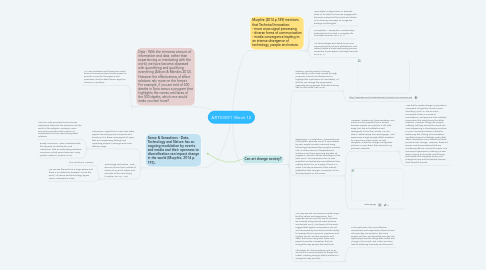
1. Data - With the immense amount of information and data, rather than experiencing or interacting with the world, we have become obsessed with quantifying and qualifying everything (Allison & Mendes 2012). However the effectiveness of affect relations rely more on the former. For example, if you are told of 500 deaths in Syria versus a program that highlights the names and faces of the 500 deaths, which one would make you feel more?
1.1. Art, documentaries and these new media forms of communication has the power to provide a voice for the passive and powerless, like the dead fishes caught on GoPros in Leviathan.
2. Sense & Sensations - Data, Technology and Nature has an ongoing modulation by events and media and their openness to diversification can impact change in the world (Murphie, 2014 p. 193).
2.1. Prehension: Signs that on new roles within signals, becoming more immersive and transitory. It is these cross-signals of signs that are reorganising feelings and impacting people in stronger and more affective ways.
2.1.1. Cloud in Sidra provides that immersive experience that pulls the audience into the world of the subjects, creating a more personal connection with a sense of immediation that can lead strong affect relations
2.1.2. Bodily Immersion: When combined with the capacity for abstraction and interaction, with an embodying interface, immersive virtual space becomes a very potent medium (Murphie 2016).
2.2. Technology and Nature - Tech does not come from outside of nature all is part of nature and amounts to the same thing (Murphie, 2014 p. 192).
2.2.1. The World as a Medium
2.2.2. We can see the world as a huge sphere and there is no distinction between us and the world , of nature and technology (Dyson 2009). Participation is key.
3. Murphie (2014 p.189) mentions that Technical Innovation: - more cross signal processing - diverse forms of communication - media convergence leading to an intense divergence of technology, people and nature.
3.1. New digital configurations in artworks allow us to reflect on how we engage with the wider material of the world and allows us to discover new ways to reorganise feelings and thoughts.
3.2. Immediation - Perception is relationship, embodied and located in everyday life (Christoph Brunner 2012, p. 1).
3.3. Art, technologies and statistics are now moving beyond just pure abstractions, and rather provide a more relationship process immanent to perception (Christoph Brunner 2012, p. 1).
4. Can art change society?
4.1. Graham: remind people of human vulnerability on the road, spread through museums, schools and businesses to highlight the importance of road safety. Art like this can change the way people, especially young people think about being safe on the roads (ABC 2016).
4.1.1. http://www.abc.net.au/news/image/7648238-3x2-940x627.jpg
4.2. Belongings: An installation I personally saw at this years' Biennale event. It was created by SBS’ Digital Creative Labs and using technology developed by Google’s Creative Lab, to shares stories of displacement, resilience and hope spanning decades of migration, diverse cultures and stages of life (SBS 2018). This experience for me was impactful and extremely more affective than reading about it in on a page of even in a video. The interactiveness of the artwork establishes that stronger connection to the life-size people on the screen.
4.2.1. However, I believe art, documentaries, and media can be impactful but is limited because people can just turn it off, walk away from the art installation and distinguish it from their minds. For me, when I walked away from Belongings, I did experience a high enough affect sensation to impact any actual action to help refugees, or want to change immigration policies or even share their stories to my personal networks.
4.2.1.1. I see that to create change, or provoke a movement, things like Florida School Shooting March, or The #MeToo movement, there is a sense of immediation, and personal and relatable connection that easily forms the affect relations. However, things like people suffering half way around the world, the Wars happening in developing countries or even University Teacher's Strike for better pay, the lacking of immediation, and that personal relatability makes that affect connection more difficult and thus, produces less change. However, these art pieces, and documentaries that are combining data to real world events, and immersive experiences is taking a closer step to trying to show the world things that matter and hopefully evoke and change the way we think about how we think about the world.
4.2.2. Belongings
4.3. We carry around unconscious mental maps, built by nature and experience, that organize how we scan the world and how we instantly interpret and order what we see (Brooks 2016). The topics of this week suggest that digital incorporation into art and documentary and media has the ability to reassign those conscious cognitions and implant visuals, and the emotions and affect that come along with those, into people to evoke a sensation that can change the way people feel and think. Ultimately, art, documentaries and so on are tools to connect people to things that matter, creating stronger affect relations to change the way we think.
4.3.1. To be optimistic, the more affective connections and experiences these art and documentary can produce, the more people will see, and hopefully one day, the right people see the things that matter and change in the world, and in the mind can lead to bettering humanity and the world.
